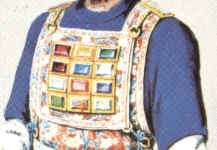Stand firm therefore, HAVING GIRDED YOUR LOINS WITH TRUTH, and HAVING PUT ON THE BREASTPLATE OF RIGHTEOUSNESS, (Ephesians 6:14)
The breastplate of righteousness is listed second among the elements of the armor. Again we see Paul's words in Ephesians capitalized indicating this is a quote from the Tanakh. Paul is referencing Isaiah 59. Isaiah 59 gives us the first Scriptural reference to a "breastplate of righteousness" and includes several references to the other pieces of armor as well.
Isaiah 59:17
He put on righteousness like a breastplate, And a helmet of salvation on His head; And He put on garments of vengeance for clothing And wrapped Himself with zeal as a mantle. (Isaiah 59:17)
The "He" in this verse refers to G-d. He puts on righteousness like a breastplate. To the Hebrew minds of Isaiah's day, the breastpiece of the high priest is a visible picture of the breastplate of righteousness. G-d has put on righteousness like the breastpiece He commanded for the high priest. The picture once again is that when we clothe ourselves with Messiah, we are putting on the righteousness with which He has clothed Himself.
The Breastpiece of the High Priest
of the High Priest
Exodus 28 describes the high priest's breastpiece and calls it the "breastpiece of judgment" (choshen mishpat). It is a unique linen garment that has four rows of three stones each of which represents a tribe of Israel.
Exodus 28 describes it this way:
"You shall make a breastpiece of judgment, the work of a skillful workman; like the work of the ephod you shall make it: of gold, of blue and purple and scarlet material and fine twisted linen you shall make it. It shall be square and folded double, a span in length and a span in width. You shall mount on it four rows of stones; the first row shall be a row of ruby, topaz and emerald; and the second row a turquoise, a sapphire and a diamond; and the third row a jacinth, an agate and an amethyst; and the fourth row a beryl and an onyx and a jasper; they shall be set in gold filigree. The stones shall be according to the names of the sons of Israel: twelve, according to their names; they shall be like the engravings of a seal, each according to his name for the twelve tribes. You shall make on the breastpiece chains of twisted cordage work in pure gold. You shall make on the breastpiece two rings of gold, and shall put the two rings on the two ends of the breastpiece. You shall put the two cords of gold on the two rings at the ends of the breastpiece. You shall put the other two ends of the two cords on the two filigree settings, and put them on the shoulder pieces of the ephod, at the front of it. You shall make two rings of gold and shall place them on the two ends of the breastpiece, on the edge of it, which is toward the inner side of the ephod. You shall make two rings of gold and put them on the bottom of the two shoulder pieces of the ephod, on the front of it close to the place where it is joined, above the skillfully woven band of the ephod. They shall bind the breastpiece by its rings to the rings of the ephod with a blue cord, so that it will be on the skillfully woven band of the ephod, and that the breastpiece will not come loose from the ephod. Aaron shall carry the names of the sons of Israel in the breastpiece of judgment over his heart when he enters the holy place, for a memorial before the LORD continually. (Exodus 28:15-28:29)
Here is a chart of the stones:
| Emerald (Levi) |
Topaz |
Ruby |
| Diamond (Zevulun) |
Sapphire (Yissachar) |
Turquoise (Y'hudah) |
| Amethyst (Gad) |
Agate (Naphtali) |
Jacinth (Dan) |
| Jasper (Binyamin) |
Onyx (Yosef) |
Beryl (Asher) |
Notes about this chart:
- We do not know if the "rows" are vertical or horizontal. A horizontal arrangement is generally assumed.
- Scripture does not indicate if the order of stones is right-to-left or left-to-right. Given the right-to-left structure of the Hebrew language, the order of stones it is usually viewed that way.
- The passage does not tell us if the stones are given in order from the perspective of Aharon or of someone looking at him.
- The Hebrew of Exodus 28 does not provide the order of the names to be written on the stones; however, the Targums (ancient Aramaic translations of Scripture) do include them. The names listed in the chart above are based upon Targum Neofiti which dates to the second century CE.
As Aharon (or the high priests that served after him) went before the Lord, then they were interceding on behalf of the Israelites. These indeed were spiritual matters and spiritual battles, and this is indeed a breastpiece ordained by G-d for such combat.